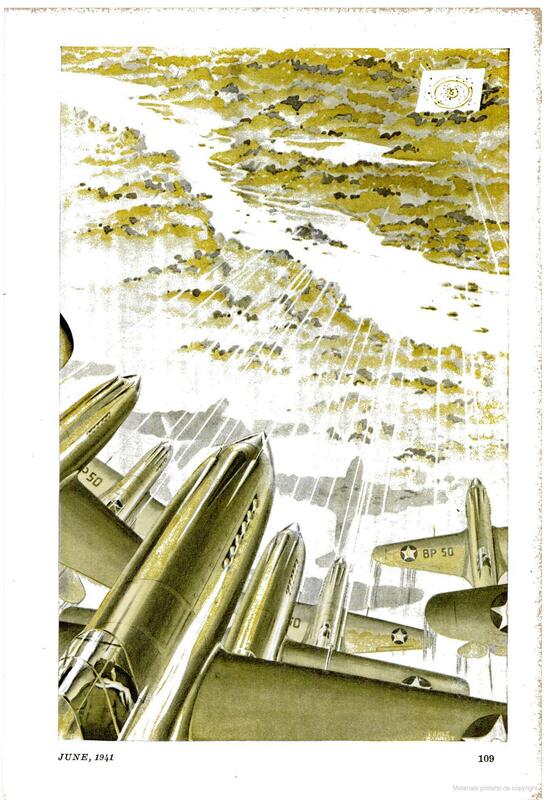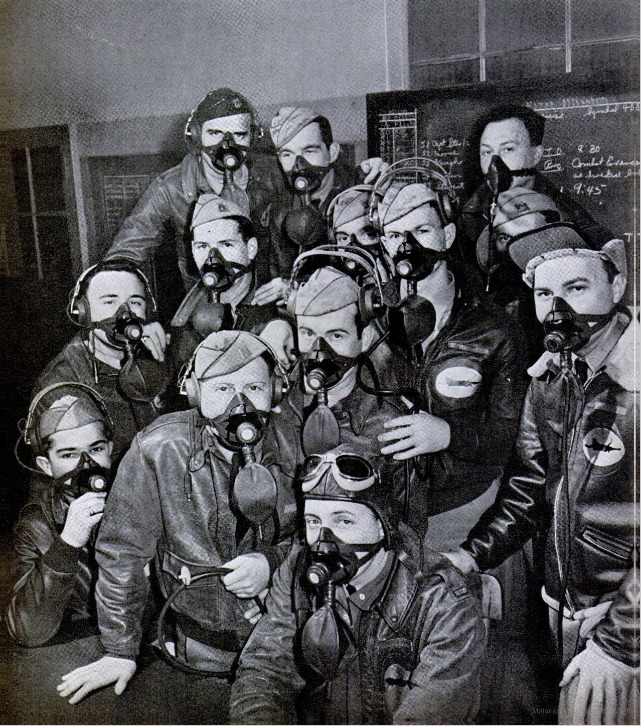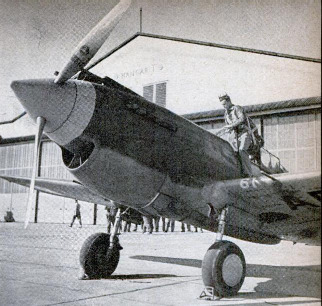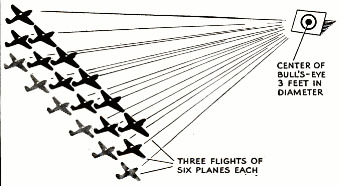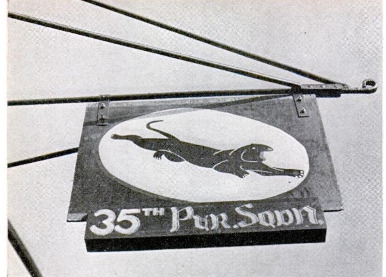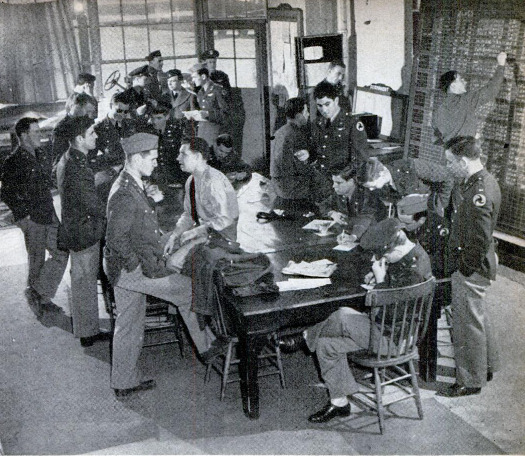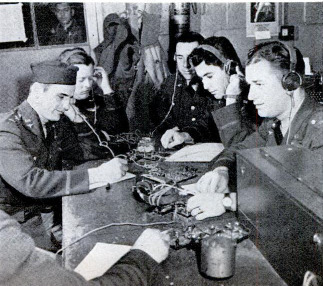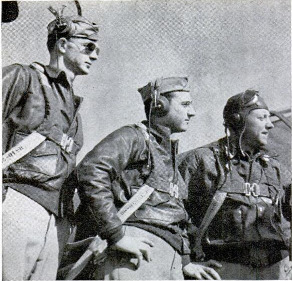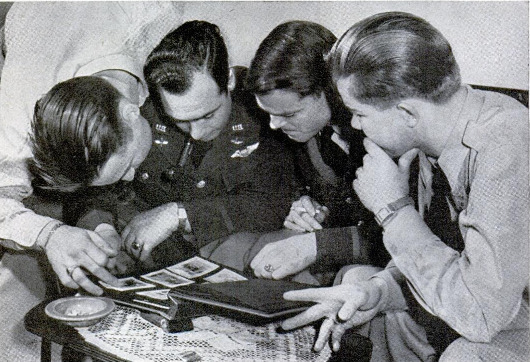-
Title (Dublin Core)
-
Dog lighting is a pursuit pilot's business
-
Article Title and/or Image Caption (Dublin Core)
-
Title: Dog lighting is a pursuit pilot's business
-
extracted text (Extract Text)
-
THIS is an article about dogfighting and
pursuit gunnery, but there is no use
talking about fighter planes and their
tactics without visualizing the kids who fiy
them. A pursuit plane is nothing until it
is fused with the personality of a scrappy,
cocky youngster whose skill is sharpened
and kept to a razor edge. Rush Howard
Willard, from Bay City, Mich. is a good
indication of what is involved when America
tries quickly to set up a strong air force.
Rush Willard is 22. He first had his hands
on an airplane stick at the age of six, when
his legs were too short to reach the rudder
controls. At 16 he was flying solo, and
about that same time he and a friend built
themselves a plane, out of salvage from
several wrecks. The inspectors would not
give them a license, but they hopped it over
a few fences, just to prove it would fly, then
made it into an ice boat
Rush probably would be graduating this
June from engineering school if he had not,
in the fall of 1939, attained his greatest
ambition. He was appointed a flying cadet
in the U. S. Army Air Corps. Out of a batch
of 20 applicants, he was the only one to
pass the physical exam. Out of a primary
training class of 56, he was one of 30 Who
made the grade and won their commissions
at Kelly Field last September, ater nine
months of intensive training.
Now that he had won his wings, Second
Lieutenant Willard still had a great deal
to learn about flying. Assigned to the 33rd
Pursuit Squadron, he spent the next three
months in the exciting process of mastering
a tactical airplane, a fast, powerful, single-
seat Curtiss P-40.
By the time I met him, in late winter, he
was a precision pilot, a good formation
flyer, and in the regular morning rat race
he could throw his plane around with the
best of them. He was now ready to begin
learning to be a fighter.
To most of us, the mere flying of a plane
is an accomplishment far beyond our ex-
pectations. Young Willard was already an
aviator before he enlisted as a cadet, and
that gave him about as much head start
over his classmates as a child has who
learns to read before he goes to school.
Only by a few flying hours, for instance,
did he have any advantage over the other
99 percent of cadets—like his roommate,
Lieutenant Max McNeil, from Raymond,
Wash., who had been in a plane only once
before he became a cadet.
‘Willard was one of the youngsters break-
ing in as a pursuit flyer at Mitchel Field,
Long Island, under the tutelage of Lieuten-
ant Phil Cochran, of whom I told last
month. While I waited for a chance to talk
more with Cochran, I sat around getting
acquainted with the kids.
“You know, it was POPULAR SCIENCE that
got me started in this,” said Max, when [
told why I was asking so many questions.
“I read an article on Army flying, which
got me all excited. I was a sophomore at
Washington State College in 1939 when the
flying board came around giving exams,
and I remembered that article and joined |
up.”
“That's funny,” said Rush. “I read that |
same article, and after that there wasn't |
anything I cared about but getting in the |
Air Corps. I took a physical exam every |
six months to be sure I'd be able to pass.” |
Rush went two years to Bay City Junior |
College, to qualify for the Air Corps mental |
standards. He earned his way by leading |
a 12-piece dance band.
Phil Cochran looked out of his cockpit
at Rush Willard, who was close beside him
in echelon right. Phil held up his right
fist, shook it beside the glass pane of the
canopy. Rush held up his left fist and shook
it back. A challenge had been accepted.
The pair cut out of formation and swung
off where there was plenty of room. They
separated, then drove at each other head
on, at top speed, passing close. At the in-
stant of passing, the fight was on. Now
it was a question which could turn the
quickest, without losing speed.
Back in the World War days, flyers lived
in an age of invention. The man who could
discover a new trick became an ace, be-
cause he took his opponents by surprise.
Nowadays it is about as easy to invent
some new way of throwing a plane around
as it would be for Joe Louis to produce a
blow. brand-new to boxing. The pursuit
fiyer has to learn all the tricks, as part of
his elementary knowledge. But he depends
on his turn, as a fighter depends on his left.
A pursuit plane fires only in the direction
in which it flies. The fiyer does not aim his
guns, he aims his plane. Also, it is virtually
impossible to shoot down a fighter plane
from the side, because it is moving too
fast. Therefore the dogfighter has two ob-
jectives: to get on the tail of his opponent,
and to keep the opponent off his own tail.
Only from the tail can he get a good shot.
The quick turn is the means of accomplish-
ing both these ends. That is what they
mean By maneuverabliily,
A plane built primarily
for speed has small wings,
a high wing load. In turn
ing, banked vertically
against centrifugal force,
such a plane will “mush,”
as an automobile skids; and
this slows up its turns. That
is one reason the British
planes, with lower wing
load, have done so well
against the fast Messer-
schmitts. In a close turn, a
Messerschmitt stalls.
There has been some con-
troversy about the relative qualities of
American and European fighter planes; it
has been said that the Messerschmitts can
run away from anything America produces.
I didn’t discuss this with Phil Cochran, and
certainly he wouldn't want to get mixed up
in any controversy. But it is interesting to
consider his fighting philosophy, which he
is imparting to the youngsters.
Phil doesn’t figure he is going to want to.
run away, or that his opponent will want to,
cither. He will be trying to get at a bomber,
while his opponent will be trying to protect
the bomber, and the two of them will stay
right there and fight it out. In such a
finish fight he wants to be able to excel in
the turns.
“The guy that can turn inside the other
will win,” he tells the kids. So they prac-
tice turns, drawing them tighter and tighter,
fighting against each other. If the turn is
too tight, then the plane stalls—that is, it
loses speed and starts to fall. The idea is
to pull the turn up just to the point of
maximum effectiveness. And of course, in
any turn worthy of the name, the fiyer
blacks out; centrifugal force drives the
blood from his head and he goes uncon-
scious for an instant. He has to go on flying
his turn precisely, while semiconscious. It
takes not only skill, but constant practice.
Chasing tails this way, one plane often
wants to duck away. A dive is bad, for
though speedy it loses altitude, the fighter's
great advantage. One helpful trick is to
dodge into a cloud. The unwary pursuer
will follow, but the wise one will climb
above the cloud and wait for his quarry to
reappear, then dive on him. Another trick
is to climb straight into the blinding sun,
and thus to lose the plane behind.
Working in all three dimensions, planes
do not merely make horizontal turns. A
pull back on the stick brings the plans up
sharp into the start of a loop, which 18 a
vertical turn. But Phil Cochran tells the
Kids that the loop is a silly maneuver.
Speed is lost, There 1s a good chance the
following plane can turn inside, and in any
case he can probably draw the loop just
as tight, 50 there is nothing to be gained.
“There Is another turn, though, used when
a pursuer is close behind. The pilot draws
himself up close and tense, then shoves the
stick hard forward. The plane noses down
and under. With a terrific jolt, the wing
load reverses. The sudden reverse strain,
of seven or elght gravities, would tear any-
thing but the best plane apart. The fiyer's
safety belt is strained to the utmost. He'd
better have hi neck pulled in, or he will
crack his head on the canopy above it. No
black-out this time, for the blood all rushes
to the head. I is very uncomfortable.
It is especially uncomfortable for the fiyer
following, for he hasn't been expecting it
and hasn't had a chance to get set. It is
embarrassing too, for In doubling under the
leading plane goes into the blind spot under-
neath ita pursuer, and for the time being
cannot be seen.
‘After Phil Cochran told me about this
violent. maneuver, 1 was talking about it
to another flying officer.
“Oh, yes,” he said. “That's one they say
the Measerschmitts use to get away from
Spitfires. The German planes have fuel in-
Sectors, which are not affected by the ro-
versal of gravity. But the Spitfire has a
carburetor, When it reverses, the carbure-
tor float control pulls up, and the engine
dies for a moment.”
Thus the fighter pilot feels for, and uses,
the weaknesses of his adversary.
Fighter planes move so fast that, when a
plane does manage to get on the enemy's
tail, the pilot must fire on the split second.
And he must aim, with microscopic ac-
curacy, at a plane which may be traveling
more than 300 miles per hour. There is no
use for a pilot even to start gunnery prac-
tice until he can fly with the utmost pre-
cision.
Rush Willard and his contemporaries
were ready, this spring, to take the ground
gunnery course—known, from its Army
regulations number, as “Four-forty dash
forty.” For this course the pilot goes to a
gunnery camp and spends three weeks.
Stretched across the range is a row of
six targets, enough for one flight to use at
a time. Fach target is ten feet wide, six
feet high, and is set at an angle of 60 de-
grees on the ground. The bull's-eye is three
feet in diameter, and there are two rings
around it.
After a certain amount of preliminary
work, the gunner starts making his runs
for score. One of his four guns is loaded
with 50 rounds. Diving on his target, his
eye glued to his sight, he must not fire
until he has passed the marker for a range
of 500 feet. Then a light touch on the
trigger, which is on the handle of his stick.
There is time for no more than four or five
shots before he has to pull out of his dive.
He has ten dives in which to fire a run of
50 rounds. Then he lands to reload and
the score is counted up. A hit on the bull's-
eye counts 5, the next circle 4, the next 3,
and a hit on the target outside the circles
is worth two. The possible score is 250.
If a man is really good he will shoot around
230.
To make an official score in “44040,” the
flyer makes two runs at 500 feet, two runs
at 700 feet, and two runs at 1,000 feet,
from right and left-hand approaches.
The good marksman does not merely aim
at the target, he aims for 5, 6, or 7 o'clock
on the bull's-eye. In a cross wind he has to
allow for “crab,” a sideways motion of his
plane. He has to have his wings precisely
level when on the target. The several guns
on the plane are set, of course, to converge
on a small pattern at a selected range.
But when the plane is tilted a variable fac-
tor enters. A bullet does not fly straight;
its trajectory is an arc, vertical to the
earth. The trajectory does not tilt with the
plane. Lift a wing and your
guns are out.
After making his score on the
ground targets, the pilot must
shoot at a moving target. This
is a tow target which is at-
tached to the end of a cable that
extends several hundred feet
behind the bomber that is flying
it. The pilot has four runs of
50 bullets, and each hole in the
sock counts one point. Several
gunners fire on the same sock,
but each has his bullets painted on the tip
with a distinctive color. The bullet which
hits leaves a telltale trace of paint around
its hole.
“There are three ratings for men who have
taken this gunnery course: Expert, Sharp-
shooter, and Marksman. To remain a pur-
suit pilot, a flyer must rate as Expert.
Ground gunnery, of course, is only
an introduction to aviation marks-
manship. The pursuit pilot must fire
at moving objects, and providing a
counterpart for actual combat shoot-
ing has always been a problem. For
a while the Army used camera guns,
but these proved to be inaccurate, for
light travels to a camera faster than
a bullet goes to its objective. Like a
duck hunter, the pursuit pilot always
has to take a lead. Today the British
are using cameras in their planes to
record the effect of combat marks-
manship on strips of motion-picture
film. But for practice something else
had to be found.
One method the Air Corps now uses
is to fly a plane over water in bright
sunlight. The shadow on the water
then becomes the target. Diving on
the moving shadow, the gunner can
determine just how accurate his fire
is, by watching the splashes.
A pursuit squadron is supposed to
have 25 planes, with three extra pilots. But
in the air its strength is 18 planes in three
flights of six, unless the squadron com-
mander chooses to fly separately as a nine-
teenth. Each flight commander's plane has
a stripe marking; each squadron has a
distinctive color for the nose, stripes, and
wheels of its
planes, as well as a distinctive insignia
painted on the planes.
All the while he is perfecting himself in
dogfighting and gunnery, the young pilot
must also be developing as a formation
flyer. He is now able to fly in complicated
tactical maneuvers with his whole squadron.
There is one maneuver which the pur-
suit flyers perform to impress foreign dig-
nitaries, and it demonstrates as well as any-
thing the skill that these squadrons attain.
“Sandwich fire,” as this maneuver is called,
is the concentration of all a squadron's guns
on a single ground target.
The 18 planes are flying in three flights
of six, each in flight front, one above
another. The squadron commander is at
the left of the top flight. The two flights
below trail a little behind, like steps.
Now the squadron commander tilts his
formation into a dive toward a three-foot
bull's-eye, far below. The steps straighten
out into a solid curtain of gun muzzles
speeding toward the target. As the planes
dive, they are all converging toward a sin-
gle point, drawing closer together.
At 2,000 feet they open fire, with all ma-
chine guns blazing away. At 1,000 feet,
still firing, every one still holding true to the
Dbull's-eye, their wing tips are nearly touch-
ing; the planes of Flight B, the “meat” of
the sandwich, have planes scarcely more
than two feet above them and two feet
below. The pilot in Flight B cannot see the
plane below him, can judge its position only
by the planes on either side. In a split
second more, all converging toward a single
point, they would come together in a tan-
gled mass of wreckage.
At this instant the flight commander
swoops his plane upward, in a left turn;
and simultaneously his flight makes a simi-
lar turn, swinging into string formation.
Immediately behind them, but at a lower
level, Flight B makes the same upward
turn, clearing the way for Flight C to pull
out of its dive. In less time than it takes
to breathe, they are flying off to the left
in normal string formation—echeloned right
just enough to keep out of each other's
prop streams.
Such a living curtain of machine-gun
fire is a horrible thing to contemplate, when
you stop to think about its ultimate pur-
pose. But with kids like Phil Cochran and
Rush Willard you don't think about things
like that. It is fast, thrilling sport. A pur-
suit squadron is like a football team, only
more S0.—HICKMAN POWELL.
-
Language (Dublin Core)
-
Eng
-
Date Issued (Dublin Core)
-
1941-06
-
pages (Bibliographic Ontology)
-
106-112,220
-
Rights (Dublin Core)
-
Public domain
-
Archived by (Dublin Core)
-
Sami Akbiyik
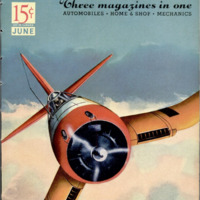 Popular Science Monthly, v. 138, n. 6, 1941
Popular Science Monthly, v. 138, n. 6, 1941

